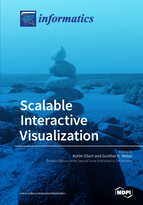Scalable Interactive Visualization
A special issue of Informatics (ISSN 2227-9709).
Deadline for manuscript submissions: closed (31 May 2017) | Viewed by 110836
Special Issue Editors
Interests: human–computer interaction; information visualization and applications
Special Issues, Collections and Topics in MDPI journals
Special Issue Information
Dear Colleagues,
Data available in today’s information society is ever growing in size and complexity—i.e., unstructured, multidimensional, uncertain, etc.—making it impossible to survey and understand this data. Traditionally, most of these datasets are stored and depicted as huge tables, hindering efficient retrieval of salient information—similarities, outliers, structures, origin, etc. Interactive visualization provides an interface to this data that can help gleaning valuable information from it, thus supporting a better data understanding by significantly reducing cognitive load on the analyst. As the term implies, two concepts form the fundamental basis of the underlying scientific methods: visualization and interaction. Combining these concepts builds a bridge between two key research areas in computer science: visualization and human-computer interaction (HCI) and brings together practitioners from many disciplines. This results in highly multi-disciplinary work with significant impact.
Applications for interactive visualization are virtually unlimited and include:
- Analysis of complex data sets (“big data”),
- Virtual reality environments,
- Augmented reality,
- Mobile Environments,
- Cooperative Work,
- Computer-supported surgery,
- Large-scale simulations,
- Experimental and observational data, and
- Sensor networks.
However, truly interactive visualizations are hard to design and implement. Researchers have to solve multiple problems, e.g.:
- Transforming complexity into simplicity,
- Efficient algorithms and implementations,
- Guaranteeing real-time performance,
- Scaling to multiple platforms and user types,
- Minimizing and managing data transfer, and
- Efficient parallel implementations.
This Special Issue will provide an insight on the current state-of-the-art of “Interactive Visualization”. It will show recent works in the field, as well as trends for future development.
Prof. Dr. Achim Ebert
Prof. Dr. Gunther H. Weber
Guest Editors
Manuscript Submission Information
Manuscripts should be submitted online at www.mdpi.com by registering and logging in to this website. Once you are registered, click here to go to the submission form. Manuscripts can be submitted until the deadline. All submissions that pass pre-check are peer-reviewed. Accepted papers will be published continuously in the journal (as soon as accepted) and will be listed together on the special issue website. Research articles, review articles as well as short communications are invited. For planned papers, a title and short abstract (about 100 words) can be sent to the Editorial Office for announcement on this website.
Submitted manuscripts should not have been published previously, nor be under consideration for publication elsewhere (except conference proceedings papers). All manuscripts are thoroughly refereed through a single-blind peer-review process. A guide for authors and other relevant information for submission of manuscripts is available on the Instructions for Authors page. Informatics is an international peer-reviewed open access quarterly journal published by MDPI.
Please visit the Instructions for Authors page before submitting a manuscript. The Article Processing Charge (APC) for publication in this open access journal is 1800 CHF (Swiss Francs). Submitted papers should be well formatted and use good English. Authors may use MDPI's English editing service prior to publication or during author revisions.
Keywords
- Interactive visualization
- Mobile visualization
- Collaborative visualization
- Virtual Reality
- Augmented Reality
- Interactive websites
- Visual analysis of time-critical data
- Interaction methods for interactive systems
- Scalability (e.g. usage on different devices)
- Real-time rendering
- Level-of-detail rendering
- High-Performance Computing
- Interactive visualization frameworks
- Evaluation studies of interactive systems
- Handling and visualization of Big Data / Smart Data
- Challenges for scalable interactive visualization
- Smart Software Ecosystems
- Data management and movement
- Data abstraction
- Feature detection






